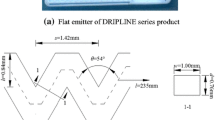Abstract
Improving the anti-clogging ability of drip irrigation emitters is the most direct and effective way to relieve the clogging issue. Different from the traditional main channel optimization method, washing the internal wall of the flow path utilizing the fully developed local vortices successfully enhanced the self-cleaning ability of drip irrigation emitters. Under this condition, appropriate internal water shear force is important for vortices’ development and anti-clogging optimization of emitter flow path. However, no related results were reported yet. Based on these, a controllable indoor experiment was carried out to systematically study the impacts of internal water shear forces on the clogging substances’ growth and explore the appropriate range of water shear forces. The results indicated that the clogging substance components using three types of reclaimed water (including solid particles (SP), phospholipid fatty acids (PLFAs) and extracellular polymeric substances (EPS)), showed quadratic patterns with internal water shear forces (R2 > 0.89, p < 0.01), and the maximum contents were observed when τ was 0.2 Pa or 0.4 Pa. As the functions and proportions differed for each component, the appropriate ranges for SP, PLFAs and EPS increment varied obviously. After a comprehensive consideration of the dynamic response of clogging substances to τ, the critical controlling threshold of internal water shear force was obtained as (0, 0.26 Pa) ∪ (0.46 Pa, 0.70 Pa), based on the conjunct range of all three components. The results acquired in this paper could provide theoretical references to anti-clogging optimization of drip irrigation emitter products.





Similar content being viewed by others
References
Bakke R, Trulear MG, Robinson JA et al (1984) Activity of pseudomonas aeruginosa in steady-state biofilms. Biotechnol Bioeng 26(12):1418–1424
Chang HT, Rittmann BE, Amar DR et al (1991) Biofilm detachment mechanisms in a liquid fluidized bed. Biotechnol Bioeng 38(5):499–506
Cloete TE, Westaard D, Van SJ (2003) Dynamic response of biofilm to pipe surface and fluid velocity. Water Sci Technol 47(5):57–59
Feng J, Li YK, Wang WN et al (2018) Effect of optimization forms of flow path on emitter hydraulic and anti-clogging performance in drip irrigation system. Irrig Sci 36(1):37–47
Horn H, Rciff H, Morgenroth E (2003) Simulation of growth and detachment in biofilm systems under defined hydrodynamic conditions. Biotechnol Bioeng 81(5):607–617
Jia XS, Fang HHP, Furumai H (1996) Surface charge and extracellular polymer of sludge in the anaerobic degradation process. Water Sci Technol 34(5–6):309–316
Lehtola MJ, Laxander M, Miettinen IT et al (2006) The effects of changing water flow velocity on the formation of biofilms and water quality in pilot distribution system consisting of copper or polyethylene pipes. Water Res 40(11):2151–2160
Li GB, Li YK, Xu TW et al (2012) Effects of average velocity on the growth and surface topography of biofilms attached on the reclaimed wastewater drip irrigation system laterals. Irrig Sci 30(2):103–113
Li YK, Zhou B, Liu YZ et al (2013) Preliminary surface topographical characteristics of biofilms attached on drip irrigation emitters using reclaimed water. Irrig Sci 31(4):557–574
Li YK, Wang TZ, Feng J et al (2014) Biofilms cultivation system for drip irrigation and its application method. Chinese Pattern: ZL 201410076970.X
Nicolella C, Felice RD, Rovatti M (1996) An experimental model of biofilm detachment in liquid fluidized bed biological reactors. Biotechnol Bioeng 51(6):713–719
Niu WQ, Yu LM, Wu PT (2010) Anti-clogging experimental investigation and optimized design of micro-channels of emitter based on isoline of sand content. Transactions of the CSAE 26(5):14–20 (in Chinese with English abstract)
Percival SL, Knapp JS, Wales DS et al (2001) Metal and inorganic ion accumulation in biofilms exposed to flowing and stagnant water. Br Corros J 36(2):105–110
Rittmann BE (1982) The effect of shear stress on biofilm loss rate. Biotechnol Bioeng 24(2):501–506
Wei ZY, Zhao WH, Tang YP et al (2005) Research on anti-clogging design method of main channel for emitter with the labyrinth flow path. Trans CSAE 21(6):1–7 (in Chinese with English abstract)
Xue S (2016) Emitter clogging material formation mechanism and growth kinetics model in drip irrigation system. China Agricultural University, Beijing (MSc dissertation, in Chinese with English abstract)
Yu LM, Mei QY (2014) Anti-clogging design and experimental investigation of PIV for labyrinth-channel emitters of drip irrigation emitters. Trans CSAM 45(9):155–160 (in Chinese with English abstract)
Zhou B (2016) Characteristics, evaluation and mechanism of bio-clogging process in drip irrigation emitters. China Agricultural University, Beijing (PhD dissertation, in Chinese with English abstract)
Zhou B, Li YK, Pei YT et al (2013) Quantitative relationship between biofilms components and emitter clogging under reclaimed water drip irrigation. Irrig Sci 31(6):1251–1263
Zhou B, Li YK, Song P et al (2016) A kinetic model for biofilm growth inside non-PC emitters under reclaimed water drip irrigation. Agric Water Manag 168:23–34
Acknowledgements
We are grateful for the financial support from the National Natural Science Fund of China (nos. 51339007, 51621061). The first author also appreciates the support from the International Postdoctoral Exchange Fellowship Program awarded by the Office of China Postdoctoral Council (no. 20160055).
Author information
Authors and Affiliations
Corresponding author
Ethics declarations
Conflict of interest
On behalf of all authors, the corresponding author states that there is no conflict of interest.
Additional information
Communicated by José L. Chávez.
Publisher’s Note
Springer Nature remains neutral with regard to jurisdictional claims in published maps and institutional affiliations.
Rights and permissions
About this article
Cite this article
Zhou, B., Li, Y., Liu, Y. et al. Critical controlling threshold of internal water shear force of anti-clogging drip irrigation emitters using reclaimed water. Irrig Sci 37, 469–481 (2019). https://doi.org/10.1007/s00271-019-00624-8
Received:
Accepted:
Published:
Issue Date:
DOI: https://doi.org/10.1007/s00271-019-00624-8




